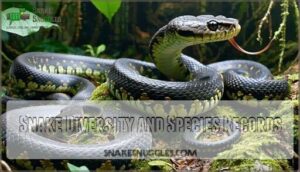This site is supported by our readers. We may earn a commission, at no cost to you, if you purchase through links.

These limbless reptiles can swallow prey three times their head size thanks to flexible jaws, while their forked tongues function like chemical detectors, sampling the air to map their surroundings.
With nearly 4,000 species worldwide, they range from 30-foot reticulated pythons to 4-inch thread snakes.
Most are ambush predators that control rodent populations, making them natural pest controllers.
Some possess heat-sensing pits that detect warm-blooded prey in complete darkness.
Their overlapping scales aren’t just armor – they’re engineered for silent movement and moisture retention.
The most surprising discoveries about their hunting strategies and survival tricks might completely change how you view these misunderstood creatures.
Table Of Contents
- Key Takeaways
- Fascinating Snake Anatomy and Adaptations
- Snake Diversity and Species Records
- Surprising Snake Behaviors
- Snake Reproduction and Growth
- Snakes’ Role in Ecosystems
- Frequently Asked Questions (FAQs)
- How many times do snakes eat in a year?
- How long do snakes usually live?
- Why do snakes shed their skin?
- What kind of diet do snakes have?
- What are 5 facts about snakes?
- What special ability do snakes have?
- What is the biggest snake facts?
- What are some dark facts about snakes?
- How do snakes communicate without vocal cords?
- What are suitable habitats for pet snakes?
- Conclusion
Key Takeaways
- You’ll discover snakes have incredible anatomical adaptations – flexible jaws that unhinge to swallow prey three times their head size, forked tongues that function like chemical detectors, and heat-sensing pits that detect warm-blooded animals in complete darkness.
- You’re looking at nature’s most effective pest controllers, with nearly 4,000 species worldwide that consume hundreds of rodents annually, making them essential for maintaining ecological balance and reducing crop damage without chemicals.
- You’ll find snakes use sophisticated hunting strategies beyond simple ambush tactics – 94% are sit-and-wait predators that strike in just 100 milliseconds, while their diverse communication methods include pheromone trails, vibrations, and complex courtship rituals.
- You’re witnessing creatures with remarkable diversity ranging from 4-inch thread snakes to 30-foot reticulated pythons, with some species laying eggs while others give live birth, and lifespans extending from 10 to 40 years depending on their size and environment.
Fascinating Snake Anatomy and Adaptations
You’ve probably never considered how snakes manage to swallow prey three times larger than their head.
These remarkable reptiles have evolved some of nature’s most ingenious anatomical solutions that’ll change how you think about biological engineering.
Limbless Bodies and Scale Structure
When you observe snakes, you’ll notice their limbless bodies showcase remarkable adaptations that define reptile characteristics.
These serpents evolved through limb loss millions of years ago, developing specialized scale patterns that serve multiple functions.
Snake anatomy features overlapping scales providing protection, moisture retention, and locomotion assistance.
The ventral scales create traction for movement, while body flex allows incredible maneuverability.
During skin shed cycles, scale function becomes evident as snakes remove parasites and accommodate growth, demonstrating how squamata classification reflects their scaly nature.
Unique Jaw and Skull Flexibility
Unlike most animals, snakes possess extraordinary cranial kinesis that allows their skull structure to flex dramatically during feeding.
Their jaw flexibility comes from quadrate bones that act like hinges, enabling the upper jaw to "unhinge" and expand.
This adaptive anatomy lets snake species swallow prey much larger than their head diameter, making their feeding mechanisms incredibly efficient compared to other reptiles, which is a result of their unique skull structure.
Sensory Adaptations (Tongue, Jacobson’s Organ, Heat Sensing)
Snakes possess remarkable sensory adaptations that put most reptiles to shame.
Their forked tongues constantly flick out, collecting chemical cues from the environment like tiny molecular detectives. These tongue samples transfer to the Jacobson’s organ in their mouth, creating a sophisticated chemical map of their surroundings.
Snakes taste the world with their tongues, building chemical maps that guide every hunt
Venomous species often have specialized heat sensors that detect warm-blooded prey in complete darkness, making them incredibly efficient ectothermic hunters.
The unique chemical detection system allows snakes to navigate and hunt with precision, leveraging their highly developed senses to survive and thrive in various environments.
No Eyelids or External Ears
The remarkable truth about snakes will change how you see these reptiles forever.
They lack eyelids and external ears entirely, making their Snake Vision and hearing uniquely different.
A transparent Brille Membrane protects their eyes, providing essential Eye Protection while they sleep with eyes open.
This Scale Function adaptation defines core Snake Characteristics, while Earless Hearing relies on vibrations through their jaw bones rather than traditional reptile characteristics.
Snake Diversity and Species Records
You’ll discover that snakes represent one of nature’s most successful evolutionary stories, with nearly 4,000 species distributed across every continent except Antarctica.
From tiny thread snakes measuring just 4 inches to massive reticulated pythons stretching over 30 feet, these remarkable reptiles showcase extraordinary diversity in size, behavior, and survival strategies, highlighting their ability to thrive in various environments with successful evolutionary stories.
Global Species Distribution
The world’s Snake Geography reveals striking Continental Distribution patterns across tropical regions.
South America dominates with 1,400 Snake Species, representing 35% of global diversity through incredible Habitat Diversity.
Africa follows with 800 species showcasing remarkable Climate Adaptation from rainforests to deserts.
Southeast Asia and Australia contribute 1,050 species combined, while North America’s Geographic Range supports only 450 species.
Europe’s limited Snake Classification includes just 50 species, demonstrating how climate shapes Species Migration and Venomous Snakes distribution worldwide.
The presence of snakes in Europe is a significant aspect of European snake diversity and ecology.
Largest and Smallest Snakes
Beyond the domain of average reptiles, you’ll find Snake Species that break all the records.
The reticulated python claims the title for Snake Length at over 30 feet, while thread snakes measure just 4 inches.
These Record Breakers showcase nature’s incredible range—from Massive Serpents that can swallow deer to Tiny Snakes thinner than earthworms.
Giant Species like anacondas tip scales at 550 pounds, proving constrictors dominate size charts.
The study of largest snakes involves understanding snake size variations to appreciate their unique characteristics.
Venomous Vs. Non-Venomous Species
Distinguishing venomous from non-venomous species isn’t just about survival—it’s fascinating science.
You’ll discover that venom delivery systems vary dramatically, while Snake Classification helps identify dangerous species through specific physical markers like heat-sensing pits in rattlesnakes.
Key Venom Types and Characteristics:
- Neurotoxic venom – Attacks nervous system, causing paralysis
- Hemotoxic venom – Destroys blood cells and tissue
- Cytotoxic venom – Breaks down cellular structures
- Cardiotoxic venom – Targets heart muscle function
- Myotoxic venom – Damages muscle tissue directly
Snake Bites from venomous species require immediate medical attention, though Toxicology studies show most encounters involve non-venomous species.
Immunity Factors in some animals provide natural protection against specific venoms.
Newly Discovered and Endangered Species
Scientists have discovered over 50 new snake species since 2020, including the Myanmar mountain pit viper with ranges under 15 kilometers.
However, Species Conservation faces major challenges as the St. Lucia racer has fewer than 20 individuals remaining.
New Discoveries using DNA barcoding reveal cryptic species in Threatened Habitats, while Extinction Risks threaten island endemics from invasive predators and illegal wildlife trade targeting these rare species.
Surprising Snake Behaviors
You’ll discover that snakes aren’t just simple slithering predators—they’re behavioral masterminds with complex hunting tactics, ingenious defense strategies, and surprising social lives.
From their perfectly timed ambush attacks to their Oscar-worthy mimicry performances, these remarkable reptiles showcase some of nature’s most fascinating survival behaviors.
Hunting and Feeding Strategies
You’ll be amazed by how different snakes approach their next meal. While some species actively hunt their prey, most prefer the ambush approach, waiting motionless until dinner walks by.
Here’s how snakes master their Hunting Tactics:
- Ambush specialists – 94% of snakes use sit-and-wait tactics, staying perfectly still until prey approaches within striking distance
- Active hunters – Only 6% actively search for food, moving through their Snake Habitat to locate meals
- Strike speed champions – Death adders execute lightning-fast strikes in just 100 milliseconds
Snake Diet varies dramatically based on their Feeding Habits. Constriction Methods involve squeezing prey with up to 300 psi of pressure, while Venom Delivery systems inject powerful toxins through specialized fangs.
Their Prey Detection abilities include heat-sensing pits that detect temperature differences as small as 0.003°C, plus chemical cues processed through their forked tongues and Jacobson’s organ. Snakes also exhibit unique strike speed abilities that aid in their hunting tactics.
Defensive Mechanisms (Camouflage, Mimicry, Rattling)
Survival hinges on deception for snakes facing predators. You’ll witness master-class performances as these serpents employ Camouflage Tactics, blending seamlessly with surroundings.
Coral snake Mimicry Strategies fool predators through false warnings. Rattlesnake Rattling Sounds create acoustic alarms, while dramatic Threat Displays involve hood flaring and body inflation.
Snake Behavior Patterns reveal sophisticated Escape Methods beyond simple slithering away. Understanding snake defense mechanisms is essential to appreciating their survival strategies.
| Defense Type | Example Species |
|---|---|
| Color Matching | Green Tree Python |
| Warning Mimicry | Milk Snake |
| Sound Production | Timber Rattlesnake |
| Body Inflation | Hognose Snake |
Nocturnal and Diurnal Activity
Most snakes follow predictable circadian rhythms that match their coldblooded nature.
You’ll find nocturnal species like pythons actively night hunting when temperatures cool, while diurnal snakes prefer day resting in warm spots.
These snake behavior patterns depend on prey availability and temperature regulation.
Their snake locomotion becomes more efficient during ideal activity windows, creating distinct habitat preferences based on thermal needs, which is influenced by their thermal needs.
Social Interactions and Communication
You’ll be surprised to learn that snakes aren’t antisocial creatures.
They use chemical signals through pheromone trails to communicate with potential mates and rivals.
Snake postures like coiling or raising their heads send clear messages about dominance.
Vibrational cues help them detect approaching threats or prey.
Social learning occurs when younger snakes observe hunting techniques from adults.
Mate selection involves complex courtship rituals where males compete through wrestling matches.
These snake behavior patterns debunk common snake myths about their solitary nature.
Snake Reproduction and Growth
You’ll be amazed by how snakes bring their young into the world through surprisingly diverse methods.
From elaborate mating rituals to the fascinating process of shedding their skin, snake reproduction and growth reveal some of nature’s most remarkable adaptations, including the diverse methods by which they thrive.
Egg-Laying and Live Birth
You’ll find that reproductive modes split snakes into fascinating categories.
About 70% are oviparous, meaning they lay eggs with leathery shells.
The remaining species use viviparity or ovoviviparity – live birth methods where mothers retain developing young internally.
Climate drives these adaptations: egg formation works best in warm environments, while live birth helps species survive in colder regions where eggs wouldn’t develop properly, which is a result of reproductive modes and the need for live birth.
Mating Seasons and Rituals
Spring awakens nature’s most intimate drama as snakes emerge from winter dormancy to continue their species.
Most snakes mate during spring when temperatures rise and food becomes abundant. Mating Habits vary dramatically across species, creating fascinating courtship displays.
Here’s how Snake Attraction works:
- Male competition – Multiple males wrestle for access to females
- Pheromone trails – Females release chemical signals males follow for miles
- Courtship displays – Males perform elaborate dances and body alignments
- Mate Selection – Females choose partners based on size and strength
Breeding Seasons typically occur once yearly, though some species mate multiple times.
Shedding and Molting Process
Every few weeks, juvenile snakes outgrow their skin like you’d outgrow old clothes.
The Snake Shedding process involves dulling colors, milky blue eyes, then rubbing against rough surfaces to peel off the entire skin inside-out.
This Snake Molting Process enables Scale Replacement and removes parasites, supporting healthy reptile characteristics through natural Renewal Patterns and Skin Regeneration cycles.
Understanding the snake shedding process is essential for maintaining healthy health in snakes.
| Shedding Stage | Visual Signs | Duration |
|---|---|---|
| Pre-shed | Dull colors, pink belly | 3-7 days |
| Blue phase | Milky blue eyes, cloudy skin | 2-4 days |
| Clear phase | Eyes clear, ready to shed | 1-2 days |
| Active shed | Rubbing, peeling skin off | Hours to days |
Lifespan and Growth Patterns
Snake lifespans vary dramatically by species, ranging from 10 to 40 years depending on size factors and environmental conditions.
Growth rates slow substantially after sexual maturity, with larger species like pythons continuing gradual growth throughout their lives.
The aging process affects mortality rates, while snake anatomy and ecology influence lifespan variations. Growth patterns connect directly to reproduction methods and the molting process.
Snakes’ Role in Ecosystems
You mightn’t realize it, but snakes are ecosystem heroes working around the clock to keep nature balanced.
These remarkable reptiles control pest populations while serving as essential food sources for many predators, making them vital players in biodiversity conservation.
Predators and Pest Control
You’ll be amazed at how snakes work as nature’s pest control specialists.
These slithering hunters keep rodent populations in check while maintaining ecosystem balance through biological control methods.
Here’s how snakes serve as natural exterminators:
- Rodent Control – A single snake can consume hundreds of mice and rats annually
- Pest Management – They target crop-damaging insects, slugs, and agricultural pests
- Disease Prevention – By controlling rodent populations, they reduce disease transmission risks
- Chemical-Free Solution – Provide biological control without harmful pesticides or poisons
- Predator Prey Balance – Maintain stable food webs by regulating small mammal numbers
For homes near snake habitats, using effective snake repellent methods can be beneficial.
Prey for Other Animals
While snakes excel as predators, they’re also essential prey in Food Chains.
Owls, hawks, opossums, skunks, and raccoons regularly hunt snakes, creating complex Animal Interactions.
This Predator Prey relationship maintains Ecosystem Balance through Wildlife Dynamics.
You’ll find snakes supporting entire food webs, feeding mammals, birds, and other reptiles that depend on them for survival.
Conservation Challenges
Fighting extinction isn’t easy when you’re slithering against the odds. Snake populations face mounting pressures that threaten their survival worldwide. Human activities create perfect storms of destruction that push these essential predators toward extinction.
Major conservation challenges threatening snake species:
- Habitat Loss – Forests cleared for agriculture destroy critical breeding grounds
- Wildlife Trade – Nearly 1 million endangered snakes traded annually, many illegally
- Human Conflict – Fear-driven killing accelerates population declines dramatically
- Disease Outbreaks – Snake Fungal Disease causes severe mortality in vulnerable populations
- Climate Change – Shifting temperatures force species migration or local extinction
Species Extinction rates climb as Wildlife Conservation efforts struggle with underfunding. Reptile Conservation programs can’t keep pace with destruction. Wildlife Preservation requires urgent action to protect Snake Importance in ecosystems before it’s too late.
Importance to Biodiversity
You’re witnessing nature’s perfect balance in action.
Biodiversity maintenance relies heavily on snake populations, which serve as both predators and prey in complex food webs.
These reptiles control pest species while providing meals for birds and mammals.
Wildlife conservation efforts recognize their ecological roles as irreplaceable.
Without proper reptile conservation, entire ecosystems would collapse, affecting plant growth and animal populations worldwide, which is why reptile conservation and maintaining biodiversity are crucial.
Frequently Asked Questions (FAQs)
How many times do snakes eat in a year?
Feeding frequency varies dramatically between species – you’ll find some snakes eating just 6-12 times annually while others feed monthly, depending on prey size and metabolic needs.
How long do snakes usually live?
Like candles burning at different rates, you’ll find snakes’ lifespans vary dramatically by species.
Most live 10-40 years depending on their size, with larger species typically enjoying longer lives than their smaller cousins, which is a complete concept that shows snakes’ lifespans can be influenced by their size.
Why do snakes shed their skin?
Snakes molt their skin because it doesn’t grow with them.
As they get bigger, the old skin becomes too tight, like outgrowing your favorite jeans.
Shedding also removes parasites and refreshes their protective covering.
What kind of diet do snakes have?
Think of snakes as nature’s ultimate food critics—they’re incredibly picky eaters.
You’ll find they’re obligate carnivores with specialized diets.
They hunt worms, insects, eggs, fish, birds, mammals, and reptiles, swallowing prey whole since they can’t chew, which makes them unique hunters.
What are 5 facts about snakes?
You’ll find these serpents fascinating: they’re limbless predators with flexible jaws that swallow prey whole.
They lack eyelids so they sleep with open eyes, use forked tongues for chemical detection.
They shed their skin periodically, and most lay eggs though some give live birth.
What special ability do snakes have?
Nature’s ultimate shape-shifters possess incredible jaw flexibility, allowing you to witness them swallowing prey twice their head’s diameter.
Their specialized cranial kinesis lets them unhinge jaw bones, consuming meals seemingly impossible for their size.
What is the biggest snake facts?
The largest snake on record reached over 36 feet long and weighed more than 500 pounds.
You’ll find these massive reticulated pythons in Southeast Asia, where they’ve evolved incredible jaw flexibility to swallow prey their own size, showcasing their incredible adaptability.
What are some dark facts about snakes?
Knowledge isn’t always kind—snakes can’t regulate their body temperature and may freeze to death in cold weather.
You’ll find that around 300 venomous species pose deadly threats to humans, while many starve between infrequent meals.
How do snakes communicate without vocal cords?
Snakes rely on chemical signals, vibrations, and body language since they can’t vocalize.
You’ll notice they flick their forked tongues to "taste" pheromones, create ground vibrations through movement, and use threatening postures like coiling or hissing to communicate with others.
What are suitable habitats for pet snakes?
Ironically, captive serpents need more controlled environments than their wild counterparts. You’ll want secure terrariums with proper heating, humidity controls, hiding spots, and species-specific substrates for superior health.
Conclusion
Wouldn’t you agree that these facts about snakes reveal nature’s most ingenious engineering?
These remarkable reptiles demonstrate evolutionary perfection through their specialized anatomy and hunting techniques.
Their flexible jaws, chemical-sensing tongues, and heat-detecting abilities showcase millions of years of adaptation.
You’ve discovered how snakes control ecosystems by managing rodent populations while displaying complex behaviors from ambush hunting to intricate mating rituals.
Understanding these facts about snakes transforms fear into fascination, revealing creatures perfectly designed for survival, and showcasing their ability to thrive through adaptation.
- https://www.britannica.com/animal/snake
- https://www.havahart.com/snake-facts
- https://aaacwildliferemoval.com/blog/snakes/snake-physical-characteristics/
- https://www.merckvetmanual.com/all-other-pets/reptiles/description-and-physical-characteristics-of-reptiles
- https://www.animalbehaviorandcognition.org/uploads/journals/26/AB_C_2020_Vol7(1)_Spain_et_al.pdf

















